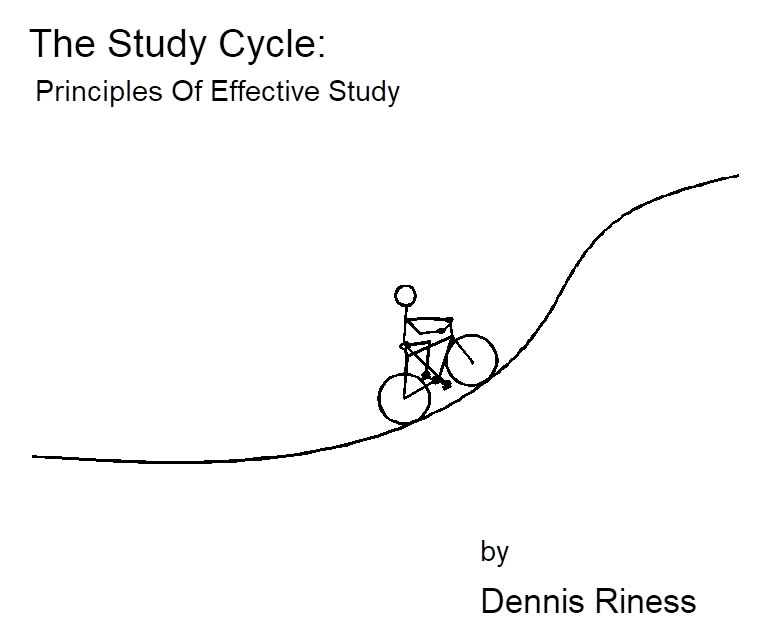
This tutorial is structured in accordance with Ergonomics of the Mind ®
Fifth Edition
May 2016
This article is published under the
Creative Commons: Attribution-No Derivatives 4.0 International License
Warning
We have a problem here. This tutorial will give you the tools you need to master any subject you chose. This tutorial contains the distilled principles of what goes on in the learning process and how to exploit them. When you master these principles, you will be able to conquer any subject. But this subject called The Study Cycle™ is one that has to be learned also. You see the problem: you don’t know how to study this tutorial that is going to teach you how to study. You begin this objective using your old study habits which are very likely inadequate.
So, dear student, please be warned. You will have to read this tutorial— aloud— several times, each time adjusting your reading technique to what you have learned so far. Three or four readings as per the recommendations and you should have it. Take all steps of The Study Cycle™ to Fluency— you will soon be learning what Fluency is— and apply them to everything you study. You will be greatly rewarded for your efforts.
The Principles of Study
The Study Cycle™ is a seven-step process the student should always follow when learning anything. The Study Cycle™ is based on the three essential principles that encompass the learning process, coupled with some study tactics. First we shall examine in turn each of the three principles that fully describe the learning process. Then these insights will be incorporated into the seven steps necessary for effective, efficient knowledge acquisition.
The Study Cycle™ is the active, systematic application on the part of the student of the three essential principles of learning. These three principles are in effect at all times whenever anyone learns anything. If the student is making an honest, energetic effort to learn, and is still having difficulties mastering the subject, it is always because one or more of these three essential principles is being violated. The violation may be the fault of the study materials— frequently the case— or it may be the student’s inappropriate methods. By understanding all three principles, the student will know what corrective action to take in order to complete the successful learning of anything.
The three principles of learning, expressed as working rules used by the student— in the order in which they are applied in the Study Cycle™— are:
| First Principle: | Ground It |
| Second Principle: | Bound It |
| Third Principle: | Take It To Fluency |
These three principles along with several tactical maneuvers are embedded in the seven steps of The Study Cycle™.
For reasons that will become apparent, the principles will be developed here in reverse order of their use in The Study Cycle™.
Third Principle: Take It To Fluency
The goal of study is the attainment of Fluency, the highest level of ability in any subject. A full understanding of this principle will become clear as you learn what it means to be “Fluent” in any subject, not just your native language. In language, Fluency means the ability to spontaneously generate the sentences that convey new ideas, instantaneously applying all the rules of grammar, syntax, emotion, etc. You “think” in the language, spontaneously and subconsciously. Fluency is the highest level of ability in any subject; it is the ability to “think’ in that subject. Fluency is the only worthy goal in study. Any lesser goal is a total waste of your valuable time as I hope you will come to realize as you learn to correctly study. You will also learn that this high level of ability is much more easily attained than you ever thought possible. The steps of The Study Cycle™ will get you to the level of Fluency faster than any other approach.
As you study, always keep the end goal of study— Fluency— in mind. Do not allow yourself to drift into any lesser goal.
Second Principle: Bound It
The Glue of a subject must be Bounded before Comprehension and then Fluency can be achieved.
Corollary 1: Learning is a threshold phenomenon.
Corollary 2: Learning is non-linear.
Whenever the mind encounters a new subject, whether it is an academic subject like biology or chemistry or accounting or literature, or whether it encounters a physical subject like ceramics or platform diving, it experiences a certain amount of chaos or ambiguity.
This chaos must be overcome before the subject is Comprehensible. If you look at every subject as if it were an athletic game, such as football, what the mind encounters are the problems of identifying what are the essential components of this subject— its players and the playing field— and what are their characteristic interrelationships— the rules of their game. This collection of essential elements and their interrelationships is what I call the Glue of the subject. The Glue is the minimum essential elements and their interrelationships that are required to make that subject— whatever it is— that subject. The Glue is what holds the subject together. If you remove one element of the Glue, that subject will no longer be identifiable as that subject and it will lose at least one of its functions that make it that subject.
For example, the automobile is a system, as all subjects are systems— or games, chose your favorite analogy— and it necessarily has a unique Glue. The engine is part of the Glue of the automobile; the windshield wipers are not. If you remove the engine from an automobile, it will not function as an automobile. If you remove the windshield wipers it will still function as an automobile, perhaps not quite as efficiently in the rain, but it will nevertheless get you down the road without those windshield wipers. Thus as a quick example, the engine is part of the Glue of an automobile, the windshield wipers are not.
The mind must find the Glue of a subject in order to achieve first Comprehension and then Fluency, the ability to think in that subject. Comprehension always precedes Fluency. Comprehension is when the mind first Bounds the Glue of a subject but has not yet developed it sufficiently to be at Fluency. When the mind at last finds all the elements and their interrelationships that belong to the Glue, the chaos begins to subside in the mind and the subject becomes easier and easier. Once the mind has found the Glue, we say the subject has been Bounded. That means the Glue has been discerned; Comprehension of the subject takes place; and all additional study effort from that point forward only refines the Glue and drives it into the subconscious where Fluency can be realized.
The Study Cycle™ makes no claim as to how the mind does what it does. It only claims a technique for efficiently accessing this remarkable, wonderful ability that we have to Bound new subjects.
The acquisition of any subject can be graphed as follows:
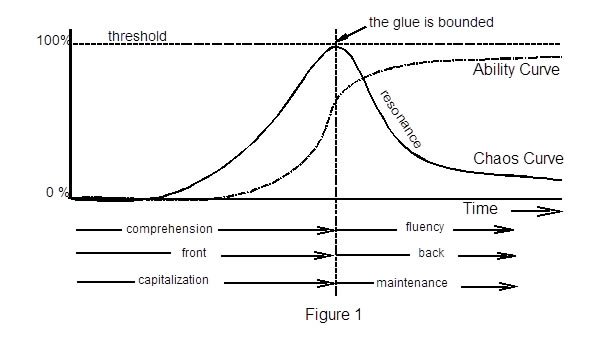
These two curves, the Ability Curve (or sometimes called the Learning Curve) and the Chaos Curve, describe the relationship between the chaos being encountered by the mind and the ability acquired.
As one gets deeper and deeper into a new subject, and before the Glue is Bounded, the chaos and hence frustration grow rapidly. The mind is searching madly for connections and relationships but it does not yet know what is an element and what is a function. It does not know which of the elements is part of the Glue and which are just “windshield wipers.” Every new subject is at first a “mind twister.” As one wades further and further into a subject this chaos grows and creates a pressure to quit pursuing this subject. One must learn to fight this pressure to quit and continue into the subject until the Glue is Bounded. We will later discuss tactics on how best to do this pursuit of the Glue.
Notice that the Ability Curve stays relatively low at first even though the fatigue of effort to Comprehend keeps growing and growing. In fact, the greatest effort is precisely at that point where the Ability Curve is sloping up the steepest. Think of the Ability Curve as a hill that you are attempting to pump your bicycle over. [See the cover for a diagram.] The fatigue you would be experiencing is shown by the Chaos Curve.
The top of the Chaos Curve must be reached in order for Comprehension to take place. This is the threshold that must be attained. The top of the Chaos Curve is the point at which the entire Glue of a subject is Bounded. There is no shortcut around or through this Chaos Curve. If one attempts to make the curve shorter by omitting some of the Glue to thus have fewer elements with which to deal, one is defeated because now the subject is incomplete— Un-Bounded— and is thus not the original subject. If part of the Glue is missing, the subject is not Bounded and has lost its unique characteristic. Many textbooks are structured in an effort to reduce the size of the Chaos Curve and all they have succeeded in doing is smearing the Glue over 700 pages and thereby making it even more difficult to see. This is the opposite of the best way to acquire the Glue. One should attempt to get over the chaos as quickly as possible. That means encounter all the elements of the Glue as soon as possible. [Corollary 1 above: Learning is a threshold phenomenon— the threshold being the Bounding of the Glue, all of it.]
What usually happens when the Glue is Bounded is that the mind has eliminated all the elements it first tried to make part of the Glue. When the Glue is Bounded all subjects get very easy and simple to understand. As one works one’s way down the backside of the Chaos Curve, Resonance is experienced. Resonance is where all the elements of the Glue and their interrelationships make small shifts in their identity and functions as the Glue of the system is refined by the mind. It is this phenomenon of Resonance that makes it impossible to linearize study. One cannot study each element of the Glue in isolation and then put them all together at the end to form a correct entire system. The elements take on their true meaning only in the context of the Glue. Until all the elements are seen at once, in their context, i.e. their relationship to each other, can they be correctly Comprehended. This is why the Ability Curve is not a straight, sloping line but rather a line with a highly variable slope. Working up the Ability Curve is not like climbing a staircase with each step the same reach as the rest. The Ability Curve is more like a staircase with one very large reach for one of the stairs right in the middle of the climb.
[Corollary 2 above: Learning is non-linear.]
First Principle: Ground It
Learning through Symbols cannot take place where there is an Un-Grounded Symbol.
Most study is done with text in books or other Symbol sources such as diagrams. To uncover the common pitfall of study we must look carefully at Symbols and how they function. The phenomenon of learning through Symbols can be diagrammed as follows:
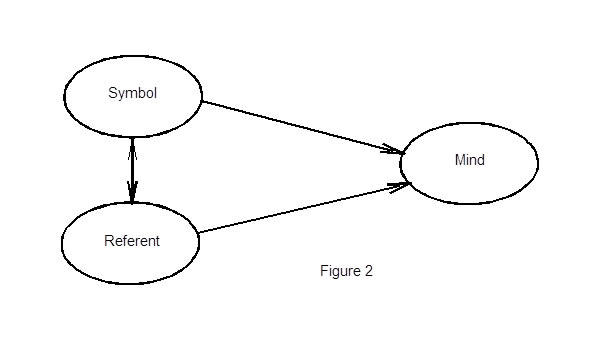
Definition: Symbols are letters, figures or other emblems, tokens or signs or marks or combinations of these used to represent something. All words are Symbols.
Definition: Referent is that which is referred to by a Symbol.
The Referent is something that exists in the physical universe that can be pointed to. The Referent is anything that can be perceived through the senses. The Symbol represents the Referent for purposes of communication. The classic observation from General Semantics is that the Symbol is not the Referent. In other words the map of the territory is not the territory.
Each leg of the Mind-Symbol-Referent triangle is important in learning through Symbols. The first important link is that between Symbol and Referent.
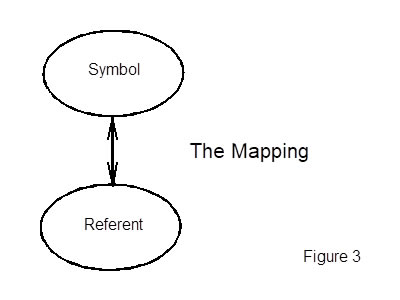
Let’s call this link the Mapping. If this link is missing in your knowledge, successful study will not be possible. In applying the Study Cycle™, this means that if you run across a word for which you do not know its Referent, you must look it up in a dictionary, encyclopedia or on the Internet and get the Mapping (exact meaning or Referent). Where Symbols represent several different Referents, you must get the correct one for your particular context, or disaster will certainly follow.
The second important link in the triangle is the one between the Referent and the Mind directly.
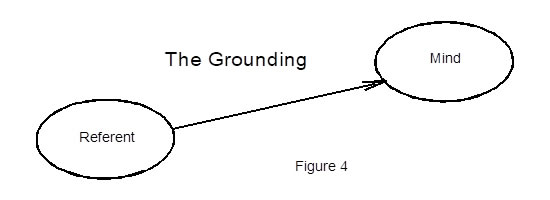
This is a non-semantic link. It is the direct perception link. It is the direct perceptual experience one has had with that Referent. Let’s call this link the Grounding. One is Grounded when one has directly perceived the Referent with one’s own senses.
If you look up a word during your study that refers to a Referent which you have never seen or experienced or the definition of a word uses another word for which you are not Grounded, you will not be able to learn that subject. This link must be present for successful knowledge acquisition to occur. In its absence you will find yourself “floating” and drifting during study. If you just deal with Symbols that are Mapped to Referents for which you are not Grounded, you will not be able to Bound the subject i.e. find the Glue of that subject.
It is possible to learn through Symbols that are mapped to Referents that you are not Grounded on, if the Symbols are very carefully and exhaustively defined in terms of Symbols upon which you are Grounded. For example, if I try to teach you what is a unicorn, you obviously have never seen a real live unicorn and hence are not Grounded on that Referent. But I define it for you as a horse—upon which you are Grounded— with one quirk: it has a single horn— upon which you are Grounded— growing from its forehead. You would now be sufficiently Grounded in the subject of unicorns, albeit indirectly, that we could communicate with the Symbol “unicorn.” But what if I defined for you something you have never seen, say, a buffcup. A buffcup is just a tranyop with an extra slouzer. Since you are not Grounded on tranyop and slouzer, there is no way you will understand my definition of a buffcup.
Develop the habit while studying of always asking yourself: “Am I Grounded on that word?” Asking yourself that question simultaneously while trying to find the Glue of that subject is like a computer with a co-processor. There are two different tasks going on at the same time, all the time.
The final link in our triangle is between the Symbol and the Mind.
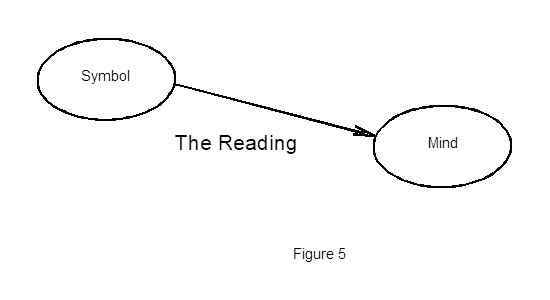
When you perceive a Symbol— it is called reading hence we call this link the Reading— it evokes the prior Grounding, whether it was a direct or indirect Grounding, and hence the mind registers a semantic reaction. This semantic reaction can be just simple identification, which is most communication, or it can be something involving the mind more deeply. For example, when you hear the latest baseball scores on the news, you are indeed learning something, but it is of a considerably lesser learning task than when you learn, say, calculus and are encountering its elements for the first time. Good study materials concentrate on getting you Grounded as quickly as possible in all elements (Referents) and their Symbols that encompass the Glue of the subject. Good study materials are rare and will be discussed more fully in the section on tactics.
For now it is enough that you be aware that conveying information through Symbols and hence learning through Symbols is a laborious process and can only work if the exposition uses Symbols that are Grounded for you. Your mandate throughout the Study Cycle™ is to always get Grounded or said another way, always find a Referent you have directly experienced.
These are thus the three principles of effective study:
- Learning through Symbols cannot take place where there is an Un-Grounded Symbol. [Ground It]
- The Glue of a subject must be Bounded before Comprehension and then Fluency can be achieved. [Bound It]
- The goal of study is the attainment of Fluency, the highest level of ability. [Take it to Fluency]
All of your study difficulties will be a violation of one— or more— of these three principles. Being Fluent in these principles will guide your study actions into the most efficient they can be. Most importantly you will always be able to answer the key question: “Is this difficulty I’m having with learning this subject, me or the materials I’m using?” These principles of effective study supply the correct answer to this question and hence guide your study actions.
Knowing these principles, we now look at the Study Cycle™ itself for the exact, step-by-step procedures to get us to Fluency on any subject.
Part II The Steps Of The Study Cycle
Step One: Start It
All cycles of human action have three distinct components:
- a start
- doing-something
- a finish
A Stop is when you are interrupted in the doing-something phase. Stops are the formula for wasted time and energy. The key to time and energy management is complete your cycles without interruptions (stops) in the middle as much as possible. The Study Cycle™ is no exception. Your start must be made with the goal of completing something before you break off and start another cycle of some kind.
Additionally, you must be able to physically perform the Study Cycle™ once you start it. This means adequate food and rest. It means a quiet place with no phones, radios, TV’s etc. and the supporting study materials at hand. The library is probably the worst place to study but you may have to be there during part of the Study Cycle™ to access the supporting study materials. There will be more on this in the tactics section.
The best time-management/self-discipline device I have found is to have a fixed time every day to begin your study. Think of it as a job that requires you to “clock-in” each day at the start of the shift. If you fix 7pm as your starting time, count yourself late if you start at 7:05pm.
Step Two: Overview It
As much as possible, get an Overview of the subject before wading into the details. This Overview can be done by a book’s preface or forward; sometimes the first chapter; a dictionary or an encyclopedia article. The Internet is an excellent resource for every subject. A live, classroom lecture can provide an excellent start on a new subject.
The objective of getting an Overview is to discern as well as possible the scope or outline of the subject. With what part of this universe does this subject deal? Can its major components and “rules of the game” be understood in broad outline before the refinements are discussed? A good Overview will also indicate what the subject does not cover. The Overview helps establish the boundaries of the subject. The objective in the Study Cycle™ is to find the Glue as quickly as possible and a properly designed Overview can go a long way toward this objective.
Sometimes an Overview is not provided in the study materials. In that case try to perceive your own by scanning the study materials. Look for diagrams that encapsulate a lot of data. If working in a textbook, use the table of contents as an Overview. In any event you should only spend about 10 minutes providing your own Overview if one is not provided. If a nice one or two page Overview is provided, apply the Study Cycle™ to it until you achieve some level of Fluency.
Step Three: Ground It
If you are reading a subject that is new to you, it will not take long into that subject to hit a word upon which you are not Grounded. When this happens, stop there and get that word Grounded, then resume reading. Good study materials will anticipate the need for Grounding new words and insert the definitions at precisely the point they are needed. Write down (Capture) in your study journal all words and their definitions that had to be Grounded. Also Ground any words that are used in the definitions that you are also not Grounded on.
Good study materials will be doing this defining and Grounding for you. That is their entire purpose. The ideal study material is designed such that it fully anticipates every word that is new to you and therefore Grounds it at exactly the time you need it, right where you need it without your having to consult some other reference source. I call this good Ergonomics of the Mind® when it is present. Unfortunately, this almost never happens so you, the student, must take the initiative and leave the study material when you need to and consult some other source, get the word Grounded, and then get back to your main study material. If you are weak on the prerequisites for the subject, you will be leaving the main study material often to make up for not having previously gone to Fluency on the prerequisites. This is precisely how you get your education. Education can be viewed as just a giant vocabulary-building process. When you are educated you are initiated into new concepts (new Referents) that require new words (Symbols) to conveniently express these concepts. Do not neglect this vocabulary-building process as laborious as it may seem. Also do not neglect to Ground those non-Glue words that are used in your study materials. They have applications everywhere and your time is wisely invested in learning them.
Step Four: Pump It
Your first light reading of the study material will reveal the Un-Grounded words. Once you have Grounded all the words of a paragraph or page or section—experience will teach you what is the optimum point— Pump that section looking for the “big ideas”, the Glue in other words. The “big ideas” are always “behind” the words. Pumping is reading out loud, with listening, with repetition as needed to go to Fluency. Think of the bodybuilder pumping iron. Your objective is to find the big idea— it is really the Glue— that holds that section together. This Pumping action is just repeated reading out loud, with listening, until the mind gets through this particular “mind twister” and finds the Glue. Once that moment of clarity is reached, you will find yourself capable of some Fluency on that idea. (If you have been reading silently in this tutorial thus far, you have not been studying this tutorial correctly, as was stated you would be doing in the warning at the beginning.)
Step Five: Capture It
Immediately upon reaching this moment of clarity (this is the peak of the Comprehension threshold of the Chaos Curve, see Figure 1), you should Capture the thought in its entirety, in your own and your newly Grounded words into your study journal or on audio recording. To not Capture this moment of clarity in some medium is the worst mistake you can make. It has taken an investment of your time and energy to get to this point and you want this investment to pay off as much as possible. This is the key to efficient study. By forcing yourself to Capture this moment of clarity you are creating the materials that will make the completion of the Study Cycle™ very easy. You are creating the materials that you will use to review and Pump the material to Fluency. Your materials will be much shorter than the original materials you were using to study thus making review very efficient.
If your time constraints require you to stop the Study Cycle™, this is the only efficient point at which to do so. That is because you have Captured for later review whatever it is that you covered in this study session. By Capturing the words you are Grounding as you prepare to Pump (Step Four) you also have created a logical stopping point but experience has shown that it is not nearly as efficient. Always try to get through the Bounding phase of the Study Cycle™ before stopping. Ideally one goes all through the Study Cycle™ at one sitting without any stops but experience has shown this to be logistically difficult in many cases. We are all juggling too many cycles in our lives.
Step Six: Pump It To Fluency
he only way to get to Fluency, once Comprehension has occurred, is drill, or repeated Pumping over several days or weeks. This means reading and rereading your study journal notes until you do not need notes any longer. You practice anything the way the pianist practices. A good pianist rehearses the piece until he no longer needs the music in front of him. This is true Fluency. Do not be surprised if you see some errors or clumsiness in your original notes. Make these changes as you discover them. This is Resonance you are experiencing and says you are truly gaining Fluency.
Verbalizing is the best way to Pump. Give a lecture to a friend. Read your notes into a recording device. Play the recorded material back as you drive to classes.
If you have Grounded and Pumped sufficiently, a good drill is to go back to the original text. You will find that those pages that took so long to get through the first time can now be speed-read, with absolute understanding. Usually the original text is lengthier by far than your study journal notes. This rereading of the original text can take on a whole new look once you have Pumped your own notes. You will generally find details and nuances that further refine your understanding. This is just additional Resonance. Your recall will be practically total.
Step Seven: Finish It
All cycles have a finish. At some point— you will know when from experience— you will pick up your study journal notes or audio recording for another Pump and something inside you will say “No, I know what’s here. It’s time to move on.” Congratulations you have just completed the Study Cycle™.
Follow the steps on the Study Cycle™ throughout your student years and the monster exams like the SAT or GRE will be no problem. The way to prepare for the exams is to go to a movie the night before. Retire early and arrive at the test rested, well fed and confident in your ability to extract the Glue from the Symbols on that exam.
Part III Tactics
- When not to Ground and Pump.
Sometimes an author, ignorant of the concept of Glue, introduces non-Glue items into the discussion. This only impedes the acquisition of the Glue and should not be done, but it frequently is. Many times, even before you have acquired the Glue of a subject, you can sense that this particular paragraph or word or section does not pertain to the main body of the subject.
Since Grounding and Pumping take lots of valuable time and energy, one wants to conserve as much as possible. Skip the suspected section and move on looking for the Glue. However, if you bog down and Comprehension is not forthcoming after enough Grounding and Pumping, go back to the suspect section and get it Grounded and Pumped. You made a tactical error in skipping that section. On the other hand, if your suspicions prove to be correct, you have saved time overall by skipping that section.
- When the Glue is not present
Some study materials are so poorly structured that they simply do not contain the Glue. One could never reach Comprehension with those materials alone. Outside, supporting materials will definitely be needed in these cases.
It is most important that you fully experience the Study Cycle™ at least one time, all the way to Fluency to be able to gauge the experience of Bounding the Glue and the subsequent Resonance. If you apply the technique of Grounding and Pumping for a reasonable length of time and still the subject does not make sense, it is because part of the Glue is missing.
The most common fault of study materials is that they attempt to reduce the Chaos Curve down to a minimum by isolating the elements of the Glue and discussing them one-at-a-time in a very linear fashion. The error is that any meaningful discussion of the elements of the Glue necessarily involves discussing/invoking the Glue. Hence what usually happens is that the material inadvertently interjects a concept from the Glue without knowing it or identifying it as such. You will discover this when you attempt to Ground a word that was thus inserted into the discussion that is actually is an element of the Glue. This is attempting to explain the Glue by using the Glue. That is as unacceptable as a dictionary using the word it is trying to define in its definition of that word. As you grow more sensitized to the concept of the Glue of a subject, you will be able to instantaneously spot this error in the study materials. Your careful study notes will allow you to correct out this defect when you write a study book on the subject.
The Study Cycle™ shows that the best time to plan a book (or article or study manual) on a subject is the first time you encounter that subject. You approach the subject the first time with an uncluttered, unprejudiced mind and are the most sensitive to the Glue of a new subject. Once you speak like an adult, you cannot— without elocution lessons and Pumping— speak like a child. Authors who long ago have gone to Fluency on their subject forget what it was like to not know their subject. I think every book I have read by a Professor Emeritus is guilty of this.
- Inflow/ Outflow
In a very metaphysical sense, study is an inflow phenomenon. Great amounts of data are inflowing into the mind. We all seem to have a finite capacity to absorb before we must outflow. If you have done every step of the Study Cycle™ correctly and still seem to be sitting there with nothing happening, it is time to outflow. Do not sit down and begin some light reading or TV viewing where your eyes are focused at a short distance.
The best outflow is to do some physical exercises, especially a ball-type game, such as tennis, which requires you to physically move about and constantly readjust your focus.
Talking is also an excellent way to outflow. Teaching is especially good. This is partially why so much verbalization is emphasized in the Study Cycle™. It helps keep the inflow/outflow in balance.
- Gaps
Gaps in your regimen are devastating. There is no way to ever make up for a missed study session. Keep yourself honest and log those study sessions like you would keep time for an employer. The weight lifter who gaps out today cannot make up for a missed workout by working twice as long tomorrow. Neither can a student.
Get that regimen in and keep it in. Keep yourself honest by logging your study sessions. This is the only way you will know where you are. Remember that it takes a minimum of six weeks to change habits, provided you have not gapped out. It takes longer to change if you have gapped out. Keep that log. Then you will really know.
- Writing
Do not try to write a term paper or article on something until you have attained Fluency on your subject. Writer’s block is just attempting to be Fluent before you are Fluent. Once you have studied your subject enough and have reached Fluency, your problem will be how to get all your thoughts down on paper as fast as they come to you. Your best organizing guide to your writing is your own study journal notes. The Un-Grounded words you encountered in your study of the materials are very likely what the next student of that subject will also need. Your study notes are the foundation of your term paper or book you are writing. Generally, good writing is that which leads the reader over the Chaos Curve rather than two experts, both at Fluency, conversing on a subject.
- Glue Words for the Study Cycle™:
Here are the Glue words for the Study Cycle™ you will want to take to Fluency in all cases, in the order in which they have appeared in this tutorial:
| Ground It |
| Bound It |
| Fluency |
| Glue |
| Comprehension |
| Ability Curve |
| Chaos Curve |
| Symbol |
| Referent |
| Mind |
| the Mapping |
| the Grounding |
| the Reading |
| Overview |
| Start It |
| Stops |
| Pump It |
| Capture It |
| Finish It |
| Inflow/Outflow |
| Gaps |
| Writer’s Block |
